Nearly 2/3 of leading marketers value data-driven decisions over gut instinct. They're putting in the hours to know everything they can about their industry, competitors, and customers. And rightfully so: without a thorough market analysis, any investment, product launch, or corporate strategy is just a shot in the dark. But as you become aware of how you compare to other brands, how clients see you, and where the industry is headed, the path to business success lights up.
In this article, we'll explore the concept of market research and provide noteworthy market analysis examples that helped top-tier companies stay ahead of the curve.
What Is a Market Analysis
⭐ A market analysis is a comprehensive report that studies the current state and future trends of a particular industry. It includes data on the competitive landscape, market size, and revenue; examines barriers to entry, the demand for products and services, and customer behavior.
Industry players or government agencies regularly make these assessments to capture how the market is doing at a certain point in time. Think of it as looking under the hood of a complex machine to understand how that vehicle gets from point A to point B, or even to predict where it'll turn up next—with a market forecast.
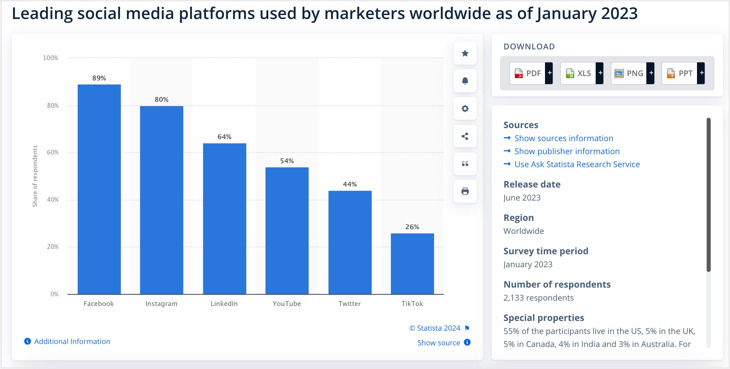
A market analysis example with findings summed up in one graph. Source: Statista
Market Analysis: Business Benefits
The main purpose of market research is to help companies identify opportunities for growth or develop strategies to overcome obstacles. In turn, a competitive market analysis is meant for surpassing competition, hence the name. Performing a market analysis allows you to:
- Ground decisions in data. Armed with hard facts and numbers, you'll be able to make informed decisions: seize chances to improve your cash flow, spot risks and threats, or recognize when it's time to seek a loan. For instance, as a construction company, you may discover that there aren't too many steel suppliers left in your niche, so they might abruptly increase prices with no competition to regulate them.
- Launch a new product. To persuade investors and guide your designers, marketers, or engineers, you'll need more than just a gut feeling. How many consumers would be interested in your type of product, and how much are they willing to spend on it? What will your unique selling proposition for the sales pitch be? A market analysis is an essential part of product development that lets you answer all of these questions, and then some.
- Gauge business performance. By seeing how your stats and KPIs compare to those of your competitors, you can assess how well the business is doing. Say, if you run an ecommerce store and notice that your digital catalog has a higher bounce rate than the industry average, you may need to rethink the interface design or the user experience.
- Reflect on past mistakes. With a market data analysis, you can evaluate your previous decisions to determine what went wrong and avoid making the same mistake in the future. Maybe you weren't using the right advertising channels, left a competitor out of sight, or didn't match the service price with customer expectations—you won't need to guess anymore.
- Stay up to date with trends. What will be a hit next season, and how can you monetize that? Let's take this quite literally: imagine you're a clothing merchandiser who looks up to high fashion brands to know what fabrics and prints to stock. With an industry forecast, you can plan accordingly and be sure that your next collection is in style.
- Attract media attention. Valuable insights, expert quotes, or well-grounded industry forecasts are bound to generate interest—which, in the digital world, equals clicks, mentions, and backlinks. If you're looking to raise brand awareness, attract more website traffic, or generate leads, all it takes is making your report public—for example, by turning it into an online flipbook.

How to Conduct a Market Analysis
For an overview on how to approach a market analysis, we'll take the example of a hypothetical real estate agency called DreamHome Realty. Let's say they are thinking of expanding their services to a new location to attract more clients and strengthen their brand.
1. Make your goal measurable
Before you dive into research, clearly define the objectives of your analysis. What questions do you want to answer? Do you wish to identify trends, assess customer needs, or cash in on some other benefits of market reports we've listed above? For each point, set key performance indicators (KPIs). Without a goal, you can't score!
DreamHome Realty decides to set a few tangible targets: a percentage increase in market share, a specific number of clients associated with the new location, and potential revenue generated from sales.
2. Gather data
Moving forward in your market research, you'll need to collect data: from industry reports, competitor evaluations, customer surveys, and internal sales or marketing metrics. For directions on how to perform a competitive market analysis, look up the 'Five Forces Framework' by Michael E. Porter. You'll find a list of factors that influence the industry and determine how attractive it is in terms of profitability.
DreamHome Realty sends their agents to conduct on-the-ground research: they visit the new location to speak with residents and potential home buyers, and observe the local real estate market firsthand. Back at the office, the agency's research team looks at demographic data and economic indicators to assess the market potential of the area.
3. Interpret findings
The next step toward a finished report is to analyze the collected data to identify trends or devise strategic recommendations. To decipher market patterns, you can employ AI-driven tools like Google Analytics' predictive metrics or IBM Watson's analytics. For competitive market research, interpret the data in the context of your company' strengths, weaknesses, opportunities, and threats—perform a SWOT analysis.
DreamHome Realty uses the analytics software that comes with their CRM system to examine the data. They discover a high demand for rental properties which isn't met by competitors, so they adjust their pricing, make out the main customer personas, and select the appropriate advertising channels for future campaigns.
4. Choose the right format
Some common elements of a market analysis are tables, diagrams, charts, more tables, and plain text pages with written descriptions of the findings. The results are usually sent out as a PDF file or posted online. However, wordy explanations and heaps of random numbers don't make for the most interesting read. How you present your research matters, too:
- Industry experts and analysts will only trust a resource that looks professional and credible, as though proving your authority in the field.
- The media and public want to see quote-worthy statements, infographics, or memorable numbers, skimming through all the 'boring' details.
- Don't forget about your own business goals: if you plan to share your market analysis online, you'll want to blend in some advertising along with hard data.
- Investors need to make quick decisions based on your report, so research methodologies and key findings have to be easily accessible and concise.
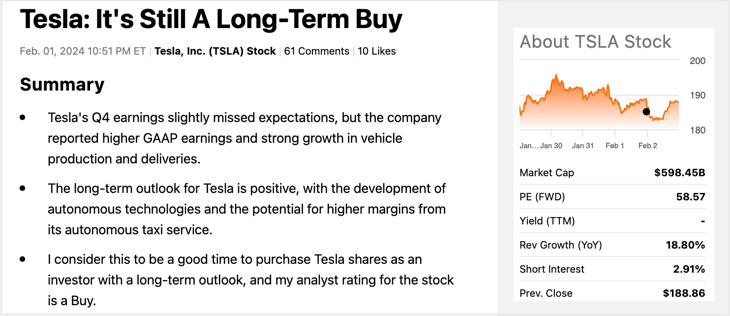
A business market analysis example that starts with a summary. Source: SeekingAlpha
One way to make your market report more attractive, convincing, and engaging is to turn it into a flipbook—an HTML5 publication with a realistic page flip effect. FlippingBook converts your analysis from a PDF in just a couple of minutes, and you get a digital document that's easy to share online via direct links or website embeds. Clients, experts, and journalists won't have to download heavy PDFs anymore: the flipbook report will instantly load in a browser on any device of their choice.
What's more, flipbooks support interactive elements, such as videos, pop-up image galleries, and GIFs. Videos help explain intricate market trends in a digestible format, while animated charts and graphs make data points more accessible and engaging. Pop-ups add more depth to the findings and effectively break up text-heavy sections, keeping your readers engaged. You may also brand the flipbook with your logo and favicon: a branded report signals that the content comes from a reputable source, and helps you stand out among competitors.
Flip through a real estate market analysis example below to see how Berkshire HomeServices makes their report versatile for different audiences. For each location, viewers can stick to the key numbers, watch a quick video, or expand a pop-up image for the whole breakdown. The top right corner has a strategically placed CTA button to drive traffic to their website, and the logo is clickable, too.
Berkshire Real Estate Market Report
Powerful Market Analysis Examples: Stories from Real Brands
Some resources for you to browse in search of industry-specific market analysis examples are:
- The U.S. Bureau of Labor Statistics—for economic releases and labor market news. Their reports don't have the most exciting presentation, though.
- Forrester—for technology and digital business forecasts. You'll need to enter your email and business phone to download reports, but some insights are openly available in their featured blog posts.
- Think with Google—for marketing trends and consumer insights. The research is displayed as longreads and shareable infographics.
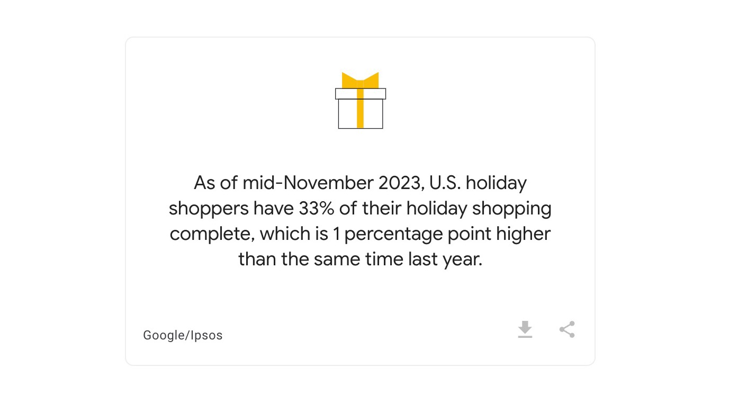
Simply looking through random examples might not be enough to ignite inspiration. It's the narratives behind the reports: their outcomes, unexpected wins, and opportunities lost—that resonate with us. We invite you to delve into five compelling stories that will encourage you to perform your own market research.
#1 Euromonitor: Data Is Everywhere
Today, Euromonitor International is an established market research agency, the likes of Forrester or Gartner. They have offices in 15 countries and a team of over 1,000 analysts and consultants. From global economic forecasts to research on Gen Z jewelry preferences, Euromonitor provides strategic intelligence on industries and consumers worldwide.
And yet, when they were just starting out in 1972, Euromonitor solely focused on analyzing data from open sources, such as government statistics and trade publications. Their reports were still valuable, since that approach allowed the agency to reach the heights they're at now. Here's an example of Euromonitor's recent market analysis: Top Five Digital Consumer Trends in 2024. You'd have to pay to see the whole report, but key findings are available for free in the overview.

The Takeaway
Before you pour time and money into conducting your own research, you can carry out a preliminary analysis of the market using open-source data. Independent agencies, trade associations, local chambers of commerce—any of these places can help you see the bigger picture of your industry. You might also find statistics relevant to your niche in trade journal articles, annual reports from your competitors, and even their online reviews.
#2 Lego: Real Insights Come from Real Customers
Lego's story is not a recent one, but it remains just as impressive: through one of their research projects, the company discovered that only 9% of their primary toy users were female. Wishing to seize the opportunity and attract a new audience, Lego decided to launch a product range just for girls. They conducted a four-year study involving 3,500 young girls and their mothers to examine their playing habits and toy preferences.
As a result, a new line called 'Friends' came out, with colorful building blocks, vibrant packaging, bigger figurines, and girly accessories. After the launch in 2012, the line doubled sales expectations, with sales to girls tripling in the same year. Ten years later, in 2022, Lego announced that 'Friends' was still among the top earning themes. By incorporating Lego cubes, their signature elements, into the market analysis design, the company effectively maintains its corporate image, which is something you could also do for your report and brand story.
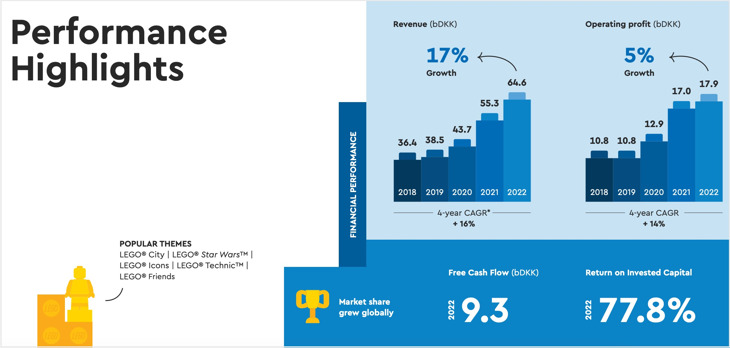
An excerpt from Lego's 2022 annual analysis.
The Takeaway
A well-rounded market analysis shouldn't solely rely on quantitative research. You might get too carried away with numbers, and forget that your customers are real people, with their personal stories, wants, and needs. Online businesses can utilize client interviews and focus groups to build a genuine connection with their audience. And if your company is brick and mortar, visit your locations from time to time to talk to clients or observe their behavior.
#3 Facebook + HTC: Even the Best Fail
The HTC First, commonly referred to as the Facebook phone, made its debut in 2013, the same year as the iPhone 4s. It was the first and only Android device to feature a preloaded interface from Facebook. For users, that meant Facebook chat was the primary messenger, and the phone's home and lock screens were constantly showing content from Facebook friends' feeds. All in all, the model aimed to offer a social media-centric experience.
Expectations were fueled by a partnership between Facebook and AT&T, the phone's carrier. Facebook went all-out with advertising, but sales were still slow. Just a few months after the launch, the original price of $99 went down to a mere 99 cents on contract, unofficially marking the demise of the new phone. Market analysts had a blast discussing the reasons behind the failure, further highlighting the missed opportunity for Facebook to conduct thorough research themselves prior to the release.
Even Forbes wrote an article on the topic, featuring quotes from different analysts. This is a great example of market report findings gaining media attention.
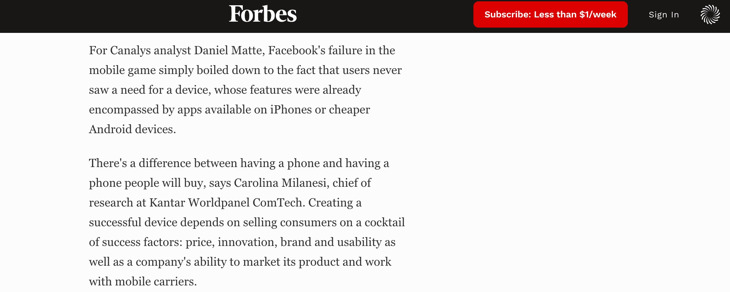
The Takeaway
Do your research before launching a new product: invest money and resources to find out everything you can about your niche, competitors, and consumers to save money in the long run. Your market analysis is basically a business plan in itself. And if a strategic decision doesn't lead to the predicted results, you'll want to take an even closer look at the state of the market to see what you've missed.
#4 Bombardier: Long-Term Vision Makes a Lasting Impact
Bombardier Business Aircraft is the industry's leading manufacturer of business jets. For more than 30 years, the company has designed, built, and supported one of the largest bases in private aircraft history: about 5,000 samples. With such a journey behind them, Bombardier is undoubtedly committed to long-term strategic planning—a quality that translates into their 20-year market forecast.
Business Aircraft Market Forecast (2011–2030)
With a report that spans from 2011 to 2030, Bombardier positions themselves as a market authority for years to come. This forward-thinking approach not only provides valuable insights for stakeholders, but also induces trust and wins over potential buyers. And as 2030 is not far away, it would be curious to see just how accurate their assessments were.
Another benefit of posting an analysis like this online is attracting a steady stream of search traffic. Since the company has chosen the flipbook format for their report, they can enable an SEO boost and have the research indexed by search engines, gaining more visibility over the years.
The Takeaway
Balance short-term and retrospective reports with market forecasts to see the big picture of where the industry is headed. The findings can enhance your business strategy, foster sustainable growth, and act as a competitive advantage in the eyes of your clients. Use digital presentation formats, namely, flipbooks, to make your research even more visible over time.
#5 Peloton: Market Insights Lead to Business Success
Peloton is an American exercise company that evolved from a Kickstarter campaign to the world's fastest-growing fitness platform with 37 offices in the US, UK, Canada, and Germany. The idea behind the brand was to make home workouts more accessible through professional equipment, such as stationary bikes and treadmills, and pre-recorded subscription-based classes.
According to SimilarWeb's analysis for traffic sources, Peloton doesn't rely on paid search: they're growing organically, through word-of-mouth. This indicates that they are delivering exactly what their customers want, turning them into self-sufficient brand advocates. At the heart of Peloton's success lies an extensive market analysis of their own. To work out their USP, they had to study the traditional gym industry and the niche of home workouts. Both had pros and cons, and Peloton's team simply combined the pros together, creating a new market position in the fitness industry.

The Takeaway
A market analysis has the transformative power to shape a successful business strategy. The industry isn't black and white: there is always untapped potential in the gray areas between established market players. Listening to customers and identifying these gaps can help you craft a competitive advantage. At the very least, it will make your report more interesting and not one-dimensional.
Summing Up
- A market analysis is a cycle of research and interpretation that keeps your industry knowledge at peak. It's not a one-time thing, rather, an ongoing investigation of what your competitors are up to, what developments impact the market, and how your target audience evolves with time.
- To conduct a market analysis, set a measurable goal and collect data: through surveys, interviews, or industry reports. Open-source stats and trade journals are also a good place to start. Listen to your customers, watch out for indirect competitors, and interpret findings to discover insights.
- Once you're done with the research part, get creative with the presentation. Use digital formats that are easy to share, spice up the formal descriptions with interactive elements and infographics, and your message will reach a wider audience. For one final market analysis example, flip through the pages of our report on the impact of AI on content marketing.
- We hope our examples and stories have inspired you to do a business market analysis of your own.





